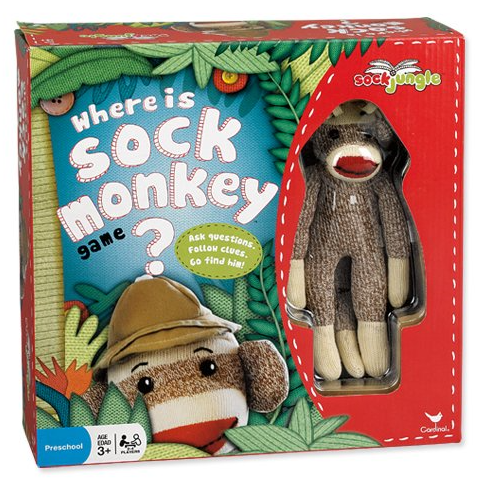 |
| Where is Sock Monkey? - Hide and Seek meets 20 Questions. |
Yes, it actually includes a small sock monkey. This game is a combination of Hide and Seek and 20 questions... with a game board. The ultimate goal is to find the sock monkey, which has been hidden somewhere in the house prior to playing the game. As you advance around the board, you get opportunities to ask yes-or-no questions that will narrow down where he is hiding.
The board is 15" x 15" and folded into fourths to fit into the box. The board is 3/4 red with the words Where is Sock Monkey?, and the words Yes and No are printed in the top corners. The oval cards each have one question or the words GO LOOK! printed on them. The front of the cards say WHERE IS SOCK MONKEY? and some of the questions on the backs are:
- In a room with toys?
- In a room with a dresser?
- In a room with a fridge?
- In a room with a lamp?
- In a room with a rug?
- In a room with a computer?
- In a room with books?
Object:
Use the clues to find the sock monkey.
Set up:
Someone hides the sock monkey somewhere in the house. Open the board and place it in the middle of the players. Mix all 29 tiles and place them face-down on the red area of the board.
Play:
Players take turns flipping a card. If there is a question, the person reads it and the person who hid the monkey will answer. If the answer is no, put it at the top of the board by the word NO. If yes, put it by the YES spot. Players will all hear the questions and answers and will be forming an idea where to look based on the answers. When someone turns over a card that says GO LOOK, he gets a chance to get up and go look for the monkey, based on the clues that have already been revealed. The game has a timer that runs for 45 seconds and the player may look until the time is up. Play continues until someone finds the monkey and is declared the winner.
Try this:
- Everybody goes to look when each GO LOOK card is turned.Make it a cooperative game.
- Forget the timer and look until someone finds the monkey or allow an extended period of time.
- Let part of the monkey stick out from his hiding place.
- Take out the GO LOOK cards and stack the deck with the yes-and-no questions you want to present. After they are answered, present a GO LOOK card and see if the player can find it based on the information.
- Skip the board and just give the player several clue cards that are YES. Then let him go look.
- After each clue is given, think about your options. For instance, say the answer is YES to whether the monkey is in a room with toys. Then consider the options that it won't be in the bathroom, kitchen or dining room. Or if he is not in a room with the fridge, then eliminate the kitchen.
- Cut out one square of paper for each room in the house and write the names of the rooms on them. As each clue is answered, add or subtract the slips of paper to reflect the room possibilities. You will not have to try and keep it all in memory this way, and once a GO LOOK card is revealed, you can look in the room(s) that you have compiled as possibilities.
- Work on visual discrimination, visual closure, manual dexterity, deductive reasoning, gross motor skills, executive functioning skills, socialization skills, process skills, play and leisure exploration and participation
- In the box: Sock monkey, game board, 22 question tiles, 7 GO LOOK tiles, 1 sand timer
If you are interested in purchasing this item or just want more information, click on the image below.



No comments:
Post a Comment
Thank you for taking the time to comment.